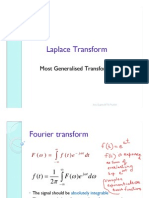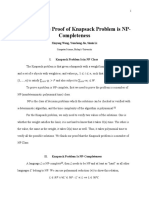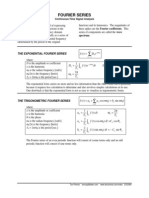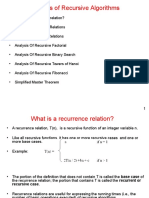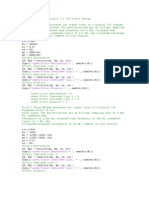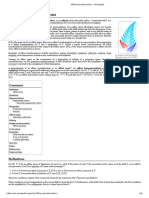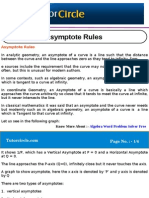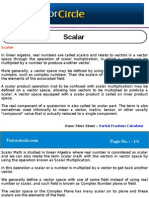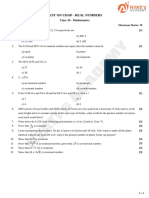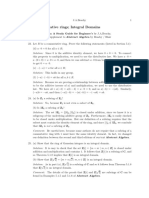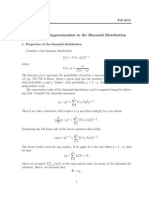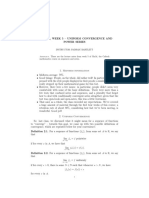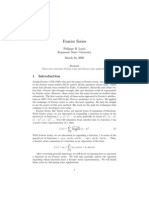Affine Transformation
Affine Transformation
Uploaded by
circleteam123Copyright:
Available Formats
Affine Transformation
Affine Transformation
Uploaded by
circleteam123Copyright
Available Formats
Share this document
Did you find this document useful?
Is this content inappropriate?
Copyright:
Available Formats
Affine Transformation
Affine Transformation
Uploaded by
circleteam123Copyright:
Available Formats
Affine Transformation
Affine Transformation an affine transformation (from the Latin, affinis, "connected with") or dilation is a transformation that takes parallel lines to parallel lines. Among the affine transformations or dilations are translations, which are characterized by the property of having no fixed point. A dilation which is not a translation has a fixed point. For every pair of line segments and in the affine plane, there is a dilation mapping the first to the second. An affine transformation preserves ratios of distances between points lying on a straight line (e.g., the midpoint of a line segment remains the midpoint after transformation). It does not necessarily preserve angles or lengths. An affine transformation is equivalent to a linear transformation followed by a translation. In the theory of affine spaces affine transformations are specified by a Marcel Berger's definition.
Know More About :- Factoring Quadratic Equations
Tutorcircle.com
PageNo.:1/4
Properties :- The invertible affine transformations (of an affine space onto itself) form the affine group, which has the general linear group of degree n as subgroup and is itself a subgroup of the general linear group of degree n + 1. The similarity transformations form the subgroup where A is a scalar times an orthogonal matrix. For example, if the affine transformation acts on the plane and if the determinant of A is 1 or 1 then the transformation is an equi-areal mapping. Such transformations form a subgroup called the equi-affine group A transformation that is both equi-affine and a similarity is an isometry of the plane taken with Euclidean distance. Each of these groups has a subgroup of transformations which preserve orientation: those where the determinant of A is positive. In the last case this is in 3D the group of rigid body motions (proper rotations and pure translations). If there is a fixed point, we can take that as the origin, and the affine transformation reduces to a linear transformation. This may make it easier to classify and understand the transformation. For example, describing a transformation as a rotation by a certain angle with respect to a certain axis is easier to get an idea of the overall behavior of the transformation than describing it as a combination of a translation and a rotation. However, this depends on application and context. Describing such a transformation for an object tends to make more sense in terms of rotation about an axis through the center of that object, combined with a translation, rather than by just a rotation with respect to some distant point.
Learn More :- Solving Logarithmic Equations
Tutorcircle.com
PageNo.:2/4
It should be known that an affine transform is sometimes known as the affine map or may also be called as affinity. It is derived from the Latin word affinis which means connected with. Now let us take some of the examples of this kind of transformation. The transation, contraction which is geometric, expansion, dilation, shear, reflection, rotation, spiral kind of the similarities and similarity type Transformations can be considered as affine maps. Their combinations are also known as affine maps. The affine type transformation can be considered equivalent to the linear type transformation which is followed by translation. The affine type transformations which are invertible form the group of the affine which possesses the common linear group of 'n' degree as the subgroup and it is itself a subgroup of the common linear group of the n + 1 degree. However the similar types of the transformations make the subgroup in which 'A' is some Scalar times of a matrix which is orthogonal. That transformation is known as an equilateral type of mapping only if we have the determinant of the matrix 'A' equal to 1 or -1. These transformations make a subgroup known as equi affine type of group. This is all about affine transform.
Tutorcircle.com
PageNo.:3/4 PageNo.:2/3
ThankYouForWatching
Presentation
You might also like
- Scilab Code For Implementing LMS Algorithm (Function) For P 2Document7 pagesScilab Code For Implementing LMS Algorithm (Function) For P 2Nikunj PatelNo ratings yet
- A Single PDF File: EE 448 Midterm ExamDocument2 pagesA Single PDF File: EE 448 Midterm ExamEDGSXCNo ratings yet
- Introduction To The Lifting SchemeDocument15 pagesIntroduction To The Lifting SchemesreenathgopalNo ratings yet
- Double PendulumDocument4 pagesDouble Pendulumvqpjau100% (1)
- Heat Transfer From Extended SurfacesDocument8 pagesHeat Transfer From Extended SurfacesHala Salah100% (1)
- Revision On MATLAB & Image Processing With MatlabDocument36 pagesRevision On MATLAB & Image Processing With MatlabHesham Fadl-Allah MohamadNo ratings yet
- Haar WaveletsDocument4 pagesHaar WaveletsSumapriya PhilipNo ratings yet
- Filter Programs MatlabDocument8 pagesFilter Programs MatlabPreethi Sj100% (1)
- Volterra SeriesDocument50 pagesVolterra Seriessaleh1978No ratings yet
- DSP Lab 1 - 03Document63 pagesDSP Lab 1 - 03Abdul BasitNo ratings yet
- Haar Wavelet Method For Solving Lumped and Distributed-Parameter SystemsDocument8 pagesHaar Wavelet Method For Solving Lumped and Distributed-Parameter Systemstanu kritikaNo ratings yet
- Optimal Control of Switching Times in Switched Dynamical SystemsDocument6 pagesOptimal Control of Switching Times in Switched Dynamical SystemsAbbas AbbasiNo ratings yet
- HD 7 Modal Analysis Undamped MDOFDocument45 pagesHD 7 Modal Analysis Undamped MDOFa_oucharNo ratings yet
- FFT & DFTDocument5 pagesFFT & DFTPoonam BhavsarNo ratings yet
- Fourier Optics: Chapter-1 Presented by Lokesh Reddy BDocument70 pagesFourier Optics: Chapter-1 Presented by Lokesh Reddy BLokesh ReddyNo ratings yet
- Introduction To Matlab Tutorial 11Document37 pagesIntroduction To Matlab Tutorial 11Syarif HidayatNo ratings yet
- DSP Lab ProgramsDocument33 pagesDSP Lab ProgramsAnonymous Ndsvh2soNo ratings yet
- The Wavelet Tutorial Part III by Robi PolikarDocument29 pagesThe Wavelet Tutorial Part III by Robi PolikarAbdullah Bin QueyamNo ratings yet
- 665 Volterra 2008 PDFDocument50 pages665 Volterra 2008 PDFpassme369100% (1)
- Laplace TransformDocument158 pagesLaplace Transformpranayreddy12No ratings yet
- Feb 24 - Linear Transformation QuestionsDocument3 pagesFeb 24 - Linear Transformation QuestionsparshotamNo ratings yet
- The Discrete-Time Fourier TransformDocument10 pagesThe Discrete-Time Fourier TransformAsif AzizNo ratings yet
- The Complete Proof of Knapsack Problem Is NP - CompletenessDocument5 pagesThe Complete Proof of Knapsack Problem Is NP - CompletenessFrank WangNo ratings yet
- EEE241-DLD Course OutlineDocument2 pagesEEE241-DLD Course OutlineZeeshan TahirNo ratings yet
- Appendix B Hand Out Gauss Newton DerivationDocument8 pagesAppendix B Hand Out Gauss Newton DerivationAbdullah ŞahinNo ratings yet
- ADC Chapter 1 NotesDocument24 pagesADC Chapter 1 NotesatifNo ratings yet
- BCS2213 - Modelling With UPPAALDocument37 pagesBCS2213 - Modelling With UPPAALChian SoonkaiNo ratings yet
- Final Exam Random Signals and NoiseDocument7 pagesFinal Exam Random Signals and NoiseqwentionNo ratings yet
- State SpaceDocument20 pagesState SpacepattanayaksuchiNo ratings yet
- Fourier SeriesDocument2 pagesFourier Seriesshahroz12No ratings yet
- Analysis of Recursive AlgorithmsDocument18 pagesAnalysis of Recursive AlgorithmsSwaty GuptaNo ratings yet
- Toc - Unit - 5 P, NP Problems P, NP, NP-Complete, NP-HardDocument6 pagesToc - Unit - 5 P, NP Problems P, NP, NP-Complete, NP-HardHARININo ratings yet
- Unit 2 - Basic Computer Engineering - WWW - Rgpvnotes.inDocument27 pagesUnit 2 - Basic Computer Engineering - WWW - Rgpvnotes.inDeepak KumarNo ratings yet
- Modes in Linear CircuitsDocument13 pagesModes in Linear CircuitsmtichyNo ratings yet
- PSD Autocorrelation NoiseDocument7 pagesPSD Autocorrelation NoiseM MovNo ratings yet
- PLLDocument4 pagesPLLAbdalmoedAlaiashyNo ratings yet
- Solucion A Algunos Ejercicios Capitulo 7Document14 pagesSolucion A Algunos Ejercicios Capitulo 7Giancarlo Blandino AbreuNo ratings yet
- Levinson and Durbin AlgorithmDocument4 pagesLevinson and Durbin AlgorithmPrathmesh P SakhadeoNo ratings yet
- An Introduction To Image CompressionDocument58 pagesAn Introduction To Image CompressionRajiv KumarNo ratings yet
- 3.3 Complexity of Algorithms: ExercisesDocument3 pages3.3 Complexity of Algorithms: Exerciseslixus mwangiNo ratings yet
- Order of Complexity AnalysisDocument9 pagesOrder of Complexity AnalysisMusic LifeNo ratings yet
- Searching Techniques in AIDocument37 pagesSearching Techniques in AIJagtar ShergillNo ratings yet
- A AlgorithmDocument9 pagesA AlgorithmPramod ChouguleNo ratings yet
- Routh HurwitzDocument14 pagesRouth HurwitzVipul SinghalNo ratings yet
- XOR Problem Demonstration Using MATLABDocument19 pagesXOR Problem Demonstration Using MATLABal-amin shohag0% (1)
- L8 Dimensional Analysis ChapterDocument36 pagesL8 Dimensional Analysis ChapterDangol RupeshNo ratings yet
- Antenna Synthesis ReportDocument10 pagesAntenna Synthesis Reportesraahabeeb63No ratings yet
- 12b) Power Series in XDocument6 pages12b) Power Series in XAtikah JNo ratings yet
- P, NP, Np-Complete and Np-HardDocument12 pagesP, NP, Np-Complete and Np-HardAyesha Firdaus100% (1)
- Interpolation, Extrapolations and Difference OperatorsDocument16 pagesInterpolation, Extrapolations and Difference Operatorsabdul latif100% (1)
- Exercises and Examples of Fuzzy Logic Controller Using Toolbox and M File of MatlabDocument27 pagesExercises and Examples of Fuzzy Logic Controller Using Toolbox and M File of MatlabAbdulrahman BastaNo ratings yet
- Lecture - Note - Unit - 6 - Turing MachineDocument51 pagesLecture - Note - Unit - 6 - Turing MachineMubarak ShikalgarNo ratings yet
- QM PostulatesDocument11 pagesQM PostulatesMobashar AhmadNo ratings yet
- Ss Important QuestionsDocument21 pagesSs Important QuestionsVeera ChaitanyaNo ratings yet
- Discrete Math Exam QuestionsDocument2 pagesDiscrete Math Exam QuestionsSandeep SajuNo ratings yet
- Heat Equation PDE MatlabDocument8 pagesHeat Equation PDE MatlabGonzalo SáezNo ratings yet
- COT5405 - Analysis of Algorithms (Fall 2021) Final Exam: Problem 1Document5 pagesCOT5405 - Analysis of Algorithms (Fall 2021) Final Exam: Problem 1Dhanush PakanatiNo ratings yet
- Advanced Engineering Math - Fourier Analysis of CTSS PDFDocument79 pagesAdvanced Engineering Math - Fourier Analysis of CTSS PDFsam nacionNo ratings yet
- Affine Transformation: Unlocking Visual Perspectives: Exploring Affine Transformation in Computer VisionFrom EverandAffine Transformation: Unlocking Visual Perspectives: Exploring Affine Transformation in Computer VisionNo ratings yet
- Eigenvalues and EigenvectorsDocument28 pagesEigenvalues and Eigenvectorsak.edu.schoolNo ratings yet
- Affine Transformation - WikipediaDocument8 pagesAffine Transformation - WikipediasukhoiNo ratings yet
- Inverse Hyperbolic FunctionsDocument4 pagesInverse Hyperbolic Functionscircleteam123No ratings yet
- Polynomial InequalitiesDocument4 pagesPolynomial Inequalitiesapi-162641823No ratings yet
- Asymptote RulesDocument4 pagesAsymptote Rulescircleteam123No ratings yet
- Inverse of FunctionDocument4 pagesInverse of Functionapi-162641823No ratings yet
- 12th Grade MathDocument4 pages12th Grade Mathcircleteam123No ratings yet
- Polygons For KidsDocument4 pagesPolygons For Kidscircleteam123No ratings yet
- 11th Grade MathDocument4 pages11th Grade Mathcircleteam123No ratings yet
- ScalarDocument4 pagesScalarcircleteam123No ratings yet
- History of TrigonometryDocument4 pagesHistory of Trigonometrycircleteam123No ratings yet
- Scalar DefinitionDocument4 pagesScalar Definitioncircleteam123No ratings yet
- Standard Deviation CalculatorDocument4 pagesStandard Deviation Calculatorcircleteam123No ratings yet
- Imaginary NumberDocument4 pagesImaginary Numbercircleteam123No ratings yet
- Algebra Word Problem Solver FreeDocument4 pagesAlgebra Word Problem Solver Freeapi-162641823No ratings yet
- The Mathematical Romance: An Engineer's View of Mathematical EconomicsDocument10 pagesThe Mathematical Romance: An Engineer's View of Mathematical Economicsmihaid_5No ratings yet
- Test On Real NumberaDocument1 pageTest On Real Numberaer.manalirathiNo ratings yet
- Dip Assignment Questions Unit-1Document8 pagesDip Assignment Questions Unit-1OMSAINATH MPONLINENo ratings yet
- P08 - 178380 - Eviews GuideDocument9 pagesP08 - 178380 - Eviews Guidebobhamilton3489No ratings yet
- Isometric Drawing: ExampleDocument8 pagesIsometric Drawing: Examplemshamid AliNo ratings yet
- 51 SolnDocument6 pages51 SolnNining Sri AstutiNo ratings yet
- A Brief Review of D-Forward Neural NetworksDocument8 pagesA Brief Review of D-Forward Neural NetworksDana AbkhNo ratings yet
- Edexcel November 1999 Paper 6Document4 pagesEdexcel November 1999 Paper 6Varun PanickerNo ratings yet
- BSArch PDFDocument2 pagesBSArch PDFLemuel Kim Cera TabinasNo ratings yet
- Assignment 4Document3 pagesAssignment 4BobaNo ratings yet
- Liceo de Buenavista, Inc.: Brgy. Poblacion, San Ildefonso, Bulacan, 3010 Philippines 326-2259Document2 pagesLiceo de Buenavista, Inc.: Brgy. Poblacion, San Ildefonso, Bulacan, 3010 Philippines 326-2259Janeyah Marie FuentesNo ratings yet
- What NARX Networks Can ComputeDocument8 pagesWhat NARX Networks Can Computecristian_masterNo ratings yet
- Fluid Mechanics Intro Problems Set 2 August 2012Document4 pagesFluid Mechanics Intro Problems Set 2 August 2012NoOneNo ratings yet
- Oscillations H2 QuestionsDocument37 pagesOscillations H2 QuestionsCealaNo ratings yet
- OL Phy 01 - Physical Quantities and UnitsDocument17 pagesOL Phy 01 - Physical Quantities and UnitsShanan GunawardenaNo ratings yet
- MAVEN: Motion Analysis and Visualization of Elastic Networks and Structure Ensembles Version 1.1 User's Manual ContentsDocument30 pagesMAVEN: Motion Analysis and Visualization of Elastic Networks and Structure Ensembles Version 1.1 User's Manual ContentsOscar DedNo ratings yet
- EGR 280 Mechanics 4 - Analysis of Structures TrussesDocument9 pagesEGR 280 Mechanics 4 - Analysis of Structures TrussesafiqzeroNo ratings yet
- The Normal Approximation To The Binomial DistributionDocument4 pagesThe Normal Approximation To The Binomial Distributionmsh-666No ratings yet
- Venkat Kasi ResumeDocument2 pagesVenkat Kasi ResumeVijay RangarajanNo ratings yet
- Simultaneous Linear Algebraic EquationsDocument18 pagesSimultaneous Linear Algebraic EquationsAbc DefNo ratings yet
- Ma1d wk5 Notes 2010Document10 pagesMa1d wk5 Notes 2010Narayan muduliNo ratings yet
- Derivation of The Convection Transfer EquationsDocument7 pagesDerivation of The Convection Transfer EquationsWalid GhamdiNo ratings yet
- Namma Kalvi 12th Maths Unit 1 Study Material em 215285Document58 pagesNamma Kalvi 12th Maths Unit 1 Study Material em 215285Aakaash C.K.100% (1)
- Surf's Up in The River Torrens InvestigationDocument3 pagesSurf's Up in The River Torrens Investigationapi-632307358No ratings yet
- Consumer's EquilibriumDocument15 pagesConsumer's Equilibriumsridharvchinni_21769100% (1)
- Din 1025-3-1994 Eng PDFDocument4 pagesDin 1025-3-1994 Eng PDFAntohi Catalin100% (1)
- Accurate Models For Bushings and Dampers..Document29 pagesAccurate Models For Bushings and Dampers..AydinNo ratings yet
- Provisional Grade Sheet: 1401297204 Akash Kumar PadhyDocument1 pageProvisional Grade Sheet: 1401297204 Akash Kumar Padhyanand swaroopNo ratings yet
- Fourier Series: Philippe B. Laval Kennesaw State University March 24, 2008Document26 pagesFourier Series: Philippe B. Laval Kennesaw State University March 24, 2008Tae Hyun HwangNo ratings yet



















